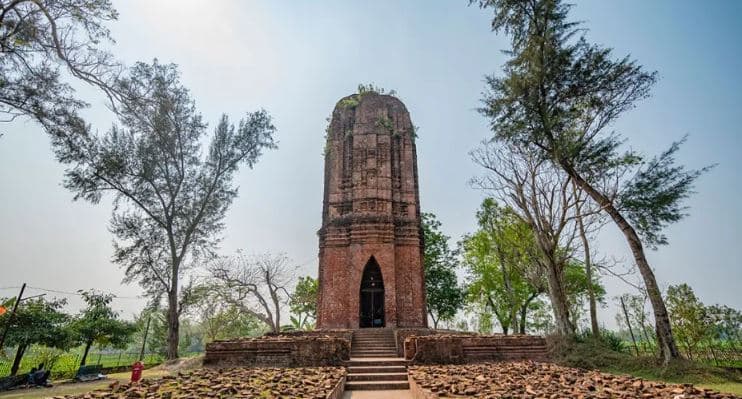To prevent corrosion of the terracotta temple, the ASI plans to replace damaged bricks and plant trees as a protective barrier
An ancient terracotta temple in West Bengal’s Sundarbans, which has survived the ravages of time for a millennia, is now facing a very modern threat. The impact of climate change, especially the increase in air salinity, is gradually eroding the outer wall of Jatar Deul, an eleventh century structure, which is located at Raidighi in South 24 Parganas, only a few kilometres from the sea.
“For the past several years, we have noticed that the outer brick wall of the temple is getting eroded, with the edge of bricks suffering steady corrosion. “We have deduced that this is due to increase in air salinity,”Shubha Majumder, Superintending Archaeologist Kolkata Circle, ASI told The Hindu.
Dr. Majumder said that the ASI plans to carry out restoration and conservation work at the temple later this year. “We are going to carefully remove the damaged bricks and replace them with new bricks of similar size,” the archaeologist explained.
While the temple is 98 feet high, the archaeologist said that the erosion is particularly seen in the bricks on the outer wall up to a height of 15 feet. “The temple stands at a vacant site. There are some trees to provide a barrier to coastal winds, particularly on the upper part of the temple, and that can be the reason that erosion is less on the upper side of the temple,” Dr. Majumder said.
Replanting a barrier of trees
Amphan, the tropical cyclone that ravaged coastal West Bengal, particularly the Sundarbans, in May 2020, had destroyed three trees at Jatar Deul, further exposing the temple to the gusty salt-laden coastal winds.
The archaeologist said that along with the restoration of the structure, the ASI has also planted trees at the site so that they can serve as a barrier to the temple. “The temple is surrounded by agricultural fields, and there is nothing to protect the 98 feet brick structure from regular saline winds or frequent cyclones,” Dr. Majumder said.
10th century inscription
The ASI website states that Jatar Deul is traditionally connected to an inscription, no longer traceable, by one Raja Jayantachandra, purported to have been issued in 975 AD. “It is evident from an earlier photograph that the temple had considerable architectural merit and closely resembled [the] Siddhesvara Temple at Bahulara, near Onda in Bankura district, on plan, elevation and decorative motifs,” says the ASI website, adding that the temple is datable to the 10th or 11th century AD on the basis of its architecture.
Sharmila Saha, an expert on West Bengal temples, disagrees with the dating estimate, saying that the temple was more likely to have been built around the beginning of the 13th century based on its architectural features. However, she agreed that the temple was facing erosion because of air salinity. “The base of the temple has suffered damage because of hydraulic action or air salinity. At the upper level of the temple, these climatic factors will take more time to have an impact,” she said.
Stone less vulnerable
Dr. Saha who has a Ph.D on the Bishnupur temples of West Bengal, pointed out that an early brick temple at Mandirtala in Sagar Island -- not far from Jatar Deul -- has been completely destroyed and razed to the ground because of the hostile climate. She explained that stone temples located along the coast -- such as the famed Konark temple of Odisha -- are less affected by salinity since the porosity of stone is far less than that of brick.
Jatar Deul is a Shiva temple and is the tallest standing temple in the Sundarbans on the bank of the river Moni, said Dr. Saha. “There are a number of oral legends on why the temple is called Jatar Deul. The temple has a curvilinear tower similar to temple architecture of the Nagara order of Odisha temples,” she added.
Along with an increase in air and soil salinity, the Sundarbans are also facing frequent tropical cyclones which cause large-scale flooding due to an ingress of sea water.







